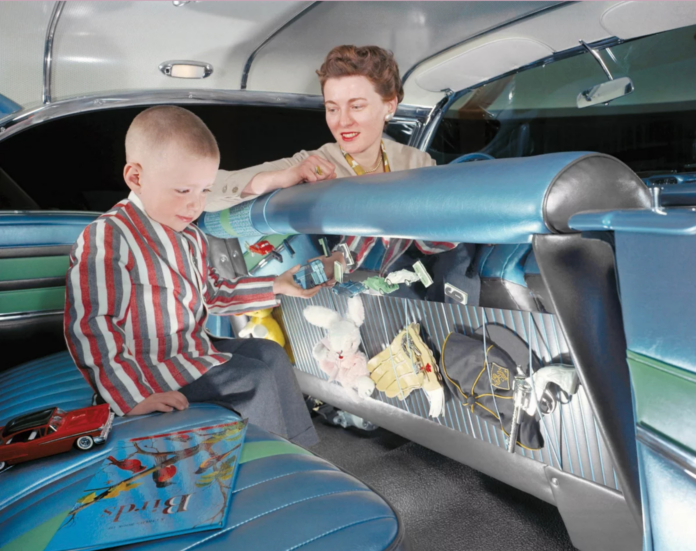
Believe it or not, there was once a prototype of a minivan that included a small washer and dryer — that way, moms could do the laundry while the kids were at soccer. That vehicle, explains journalist Nancy Nichols, was never produced, but it’s an eye-opening window into the long relationship between car manufacturers and their female consumers. …
Interview highlights
On how the invention of the electric starter made cars accessible to women

The Collections of Henry Ford/Pegasus Books
The early cars were hand-cranked, and that was part of why they were very difficult for women to drive. …There were some models in which it was very difficult for women to even reach the pedals. …
It wasn’t until 1910 when a man named Charles Kettering developed an electric starter for the car, and this was a real game changer for women because it allowed women to start the car without a great deal of personal strength, and it greatly expanded their ability to use the car when there weren’t men around. …
On car coats and automobile fashion in the 1910s
The car coat was designed to help women get in and out of the car. …So early cars were open. They didn’t have roofs. Women got dirty. They were cold. Women were sold ermine blankets. They wore goggles that evolved as the car became more enclosed.
And so women … were advised by the Ladies Home Journal, for example, to wear gloves, to have a hat with a short veil, because the act of driving a car is performative, and it’s always been expected that women dress a certain way and look a certain way. So, for example, Ford had coats that were made to match, used the same material in the interior of the car to create matching handbags, matching coats. So it was a very coordinated thing.

The Collections of Henry Ford/Pegasus Books
On how car manufacturers coached salesmen on how to sell cars to women
… The interior of the car was thought to be particularly a female space, a place for domestic arts. So this is a place where women were involved in picking the fabric of the seats or the floor mats, the interior colors. So the slogan or kind of the watchword from that time would have been, ‘He picks the engine. She picks the paint job.’
On the minivan’s reinvention — from hippie car to mom car
The hippies use the van as a kind of roving space for romance. …They had specific mood lighting. They had wine racks, they had shag rugs. ….
Fast forward a little bit to my generation, I’m a Boomer. I have always worked. I had a young son when I was working, so I use my minivan. I drove a Honda Odyssey, and I used it to meet my dual responsibilities as a mother and as a professional woman, and I’m about 65 years old.”
-Gross, T. (2024, March 28). “women behind the wheel” explains how cars became a gendered technology. NPR. https://www.npr.org/2024/03/28/1241321758/women-behind-the-wheel-nancy-nichols-car-culture
I love the idea of the car’s interior being a female space, even though the way it was done was rooted in patriarchal ideas of what a woman had to be at the time. The car coats were a genius business move by Ford to connect their users to their product. Women could match their clothes to their vehicle, choose the interior and exterior colors for the car, and really create an important space for themselves. With the transition of the minivan into a “soccer mom van”, women could both tackle their family duties and their career aspirations. This quote about how the automotive industry perfectly addressed the needs of women at the time is incredibly important:
“You have to give the American automobile industry so much credit: They were on every single demographic trend. They fully understood what women wanted and needed, and they were out to make it work for women, in very capitalist ways. They weren’t doing it out of generosity, but they did a great job. And the minivan was really created in order to help women make that transition from home to work to getting the kids to soccer.”
What do women want today? How can we address the needs of women now when they are no longer railroaded to fit into the role of homemaker, soccer mom, and working mother?
The fact that the first “female” crash test dummy was made in 2011 and was simply a slightly smaller version of the six-foot-tall male dummy is ridiculous and thoughtlessly puts women at risk. I’ve found an article about the first crash test dummy specifically designed with feminine proportions that I will include in this newspaper.



